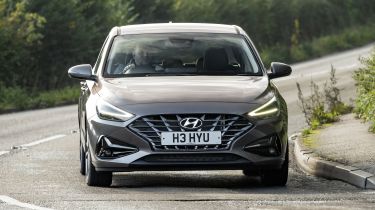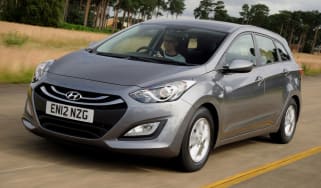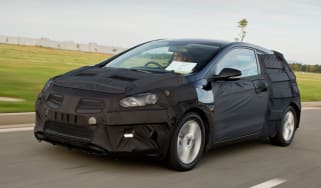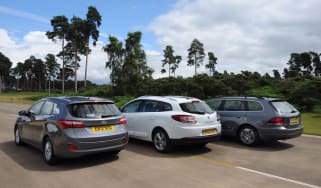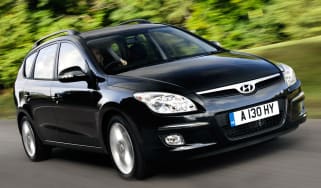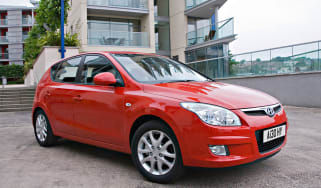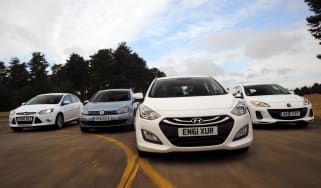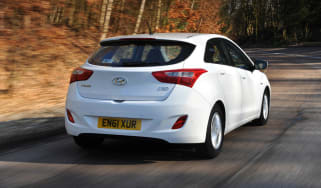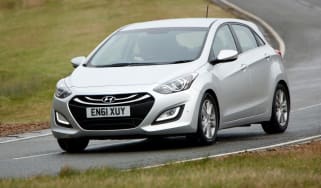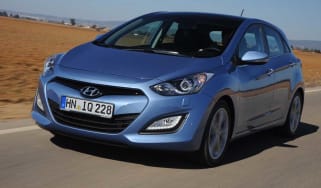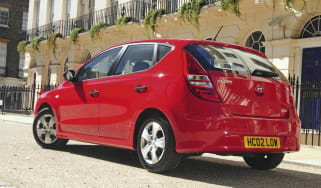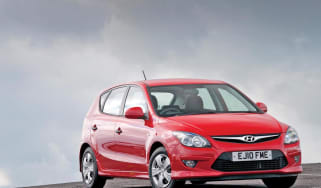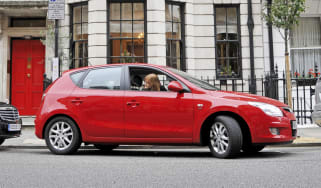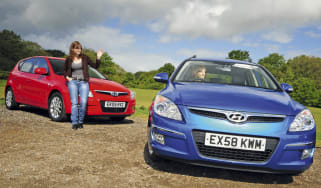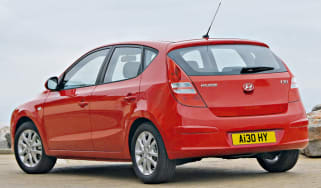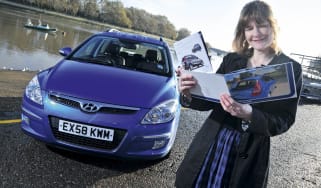Hyundai i30 review
The Hyundai i30 is a well-built and refined family car, but it fails to excite in a class with plenty of dynamic and stylish rivals

Hyundai i30 Quick Review
The latest Hyundai i30 does just enough to keep pace with a pool of very talented family hatchback rivals that includes the Ford Focus, Vauxhall Astra and Volkswagen Golf. It’s not the most exciting compact family car on the market, but it’s well built, refined and economical, and comes with a strong haul of standard equipment.
The entry-level 1.0 T-GDi petrol engine is our favourite, offering a truly grown-up driving experience despite its seemingly modest power output. A Renault Megane is more stylish and a SEAT Leon more fun to drive, but the i30 should find its way onto your shortlist if you’re in the market for a rational alternative to the Vauxhall Astra - or the mechanically similar Kia Ceed.
About the Hyundai i30
Among the talented opposition in the family hatchback class, the i30 is a bit of an uninspiring choice, but it does have its selling points. The i30 is available as a five-door hatchback, a Tourer estate and a five-door coupe-style Fastback. There are faster i30 N versions of the hatchback and Fastback.
The i30 has recently been facelifted, with a view to increasing its appeal. With striking LED headlights and a bold new grille, the i30 is certainly smarter than before - although Hyundai hasn’t gone to the same lengths as it did with the distinctive Tucson SUV. Changes are less noticeable around the back, save for a slightly jazzier set of tail-lights.There’s also a racier look for i30s with the N Line trim, as Hyundai looks to tempt buyers away from alternatives like the popular Ford Focus ST-Line range and the SEAT Leon’s FR models - trim levels that bring a sporty flavour to conventional hatchbacks by mirroring the styling of the respective hot hatch versions.
Used - available now
Within the facelift, Hyundai also streamlined the i30 range. There’s no longer a sparsely equipped S model, so SE Connect is now the entry-level specification. As a result, alloy wheels, a rear-view camera and an eight-inch touchscreen (with Android Auto and Apple CarPlay connectivity) are all now standard. N Line adds two-zone air conditioning, sports seats, a digital instrument cluster and a bigger touchscreen, while Premium is very well-equipped, with heaters for the front seats and steering wheel, and a wireless charging pad.
Engines comprise two mild-hybrid petrol units and a diesel. The range starts with the 1.0 T-GDi 118bhp turbo petrol three-cylinder (GDi stands for Gasoline Direct Injection). Given that it’s available on SE Connect and Premium versions, we expect this engine to be the big-seller. Above that sits a new 1.5 T-GDi 157bhp petrol, which is reserved for the sportier N-Line trim. There was also previously a 1.6 CRDi diesel option, but this has since been discontinued.
All models are fitted with a six-speed ‘intelligent’ manual gearbox as standard, or each one can be had with a seven-speed twin-clutch DCT auto. The upgrade is priced at £1,200, and only has a slightly negative effect on emissions and economy.
The i30 N hot hatch is the range flagship and was the first in the line of performance cars to be launched under the ‘N’ sub-brand. The latest version comes with 276bhp and 392Nm of torque.
Engines, performance and drive
The Hyundai i30 is a capable and well-rounded car, and one that easily competes with the best in class when it comes to long-distance refinement. The SEAT Leon and Ford Focus are more fun, though the entry-level i30 feels sprightly and surprisingly good to drive thanks to the lightweight three-cylinder turbo petrol engine.
What’s important with hatchbacks like this is ride quality. The i30 deals well with rough roads up to a point, beyond which the suspension starts to struggle. In spite of the new model's more sophisticated rear axle, there’s a noticeable level of body movement that can be felt from the cabin. A Volkswagen Golf is better at soaking up bumps, while the ride imperfections are exacerbated on N Line models with their firmer suspension and big wheels.
Apart from this, the i30 is a comfortable cruiser, with enough wheel control to smother most surface imperfections and keep things calm for passengers. The downside is that the Hyundai doesn’t sparkle all that much dynamically. There’s plenty of grip, but you wouldn’t know it through the steering. While Hyundai has dropped its largely ineffective FlexSteer power-assistance system, the wheel still feels lifeless, with a constant weight no matter what speed you’re doing or how much lock you add. The wheel feels inert as a result, although the fairly positive six-speed manual goes some way to rescuing the driving experience.
The entry-level 1.0-litre engine now also comes with the option of a seven-speed automatic gearbox, alongside the standard-fit six-speed manual, just like the more powerful petrol models. The automatic option costs £1,200 across the range, barely affects fuel economy and shifts smoothly under gentle acceleration. Push harder and you’ll wish you opted for the manual, though.
The new i30 N is a wonderful car to drive, so much so that we gave it a full five-star rating on our first drive in Germany. Although not as quick or powerful as a Honda Civic Type R, its terrific chassis and brilliant steering are certainly to be admired. It races to the redline with virtually no turbo lag, with a sweet-shifting six-speed gearbox adding to the thrilling drive. We also love the rev-matching tech, which allows for quick and smooth downshifts without the need to heel-and-toe.
The N model received a few mechanical tweaks in early 2020 that help it perform just a little bit more capably on UK tarmac than the original. However, the firm ride still remains, so we’d still use the excellent customisation feature to fine-tune our own ‘sport’ set-up, mixing the most aggressive power delivery with the most comfortable dampers.
There’s loads of safety kit on the new i30, most of which just works away in the background. Autonomous Emergency Braking and Front Collision Warning are both included alongside Lane Keeping Assist and Driver Attention Alert.
Engines, 0-60 acceleration and top speed
The Hyundai i30 range currently comprises two petrol engine options (three if you include the 2.0-litre in the hot hatch i30 N) – and it’s the entry-level 1.0 T-GDi turbo petrol that offers the best blend of performance and running costs.
The 1.0 is very refined. At idle it’s only possible to detect a faint hum from the three-cylinder engine, although it does get noisier when you pull away. With 118bhp and 172Nm of torque, performance is reasonable, and the i30 matches more powerful and torquier rivals; it can thank a relatively low kerbweight for that. However, in gear performance isn't quite as strong, and the i30 took 12.6 seconds to accelerate between 50 and 70mph in sixth. That's a second slower than a 1.2 TCe-powered Renault Megane, while a 1.0-litre TSI Volkswagen Golf will accelerate quicker and feels a bit less lethargic.
Next up is the more powerful 1.5 T-GDi. Also turbocharged, the bigger capacity unit doesn’t offer as many benefits as it might appear to on paper. Hyundai claims a much quicker 0-62mph sprint of 8.9 seconds, but in reality the difference doesn’t feel all that great. It’s more refined at high speed, though, feeling less stressed at the top end. Mated to the sportier N-Line spec, it looks very much like a cheaper i30N.
The flagship i30 N Performance is powered by a 2.0-litre four-cylinder turbocharged petrol engine, developing 276bhp and 392Nm of torque. Acceleration from standstill to 62mph takes 6.1 seconds, with a top speed of 155mph.
MPG, CO2 and running costs
All Hyundai i30 models return reasonable fuel economy, although the diesel, which offered around 60mpg combined, has been discontinued. Next best is the 118bhp 1.0-litre turbo petrol. It’s our pick of the range, feeling sprightly enough and agile, while also returning a decent 52mpg and emitting 121g/km of CO2.
Next best is the 118bhp 1.0-litre turbo petrol. It’s our pick of the range, feeling sprightly enough and agile, while also returning a decent 52mpg and emitting 121g/km of CO2. The diesel engine will cost more than the petrol if you’re a company-car driver, due to a higher rate of BiK tax.
The 1.5-litre turbo petrol is the least economical of the standard i30 models, emitting 143g/km of CO2 while returning 44.8mpg.
All cars come with Hyundai’s stop-start technology, which shuts off the engine in traffic. The Korean brand has also introduced mild-hybrid assistance to the petrol engines, which stores energy in a small battery to ever-so-slightly boost fuel efficiency. If you want a full hybrid or electric Hyundai, you'll need to look towards the excellent Ioniq family car or Kona SUV.
Insurance groups
The extensive list of safety kit should keep insurance prices low, while relatively modest engine outputs will ensure younger drivers can afford to run an i30 without too much trouble. Hyundai i30 insurance groups start at group 10 for an SE Connect with the petrol engine. Other spec and engine combinations sit in groups 11-16. If you want an i30N Performance model, you'll need to prepare yourself for a bigger premium as it sits in group 28.
Depreciation
The i30 will retain around 45% of its value over 3 years and 36,000 miles. The 1.0-litre T-GDI models fare a little better overall, as does the 2.0-litre N Performance version.
To get an accurate valuation on a specific model check out our free car valuation tool...
Interior, design and technology
The Hyundai i30 has been designed, developed and tested in Europe, specifically for European buyers. While that clearly affects the way the car handles on broken and uneven UK roads, it also has a bearing on how owners interact with the simple and well laid-out interior.
All models come with a touchscreen now that the base S spec is no longer available (it only had a dated-looking radio screen). The touchscreen measures eight inches on SE Connect, and 10.25 inches elsewhere. Both versions get Apple CarPlay and Android Auto, while the top version also gets Hyundai’s inbuilt sat nav system. The car feels solidly put together, though some scratchy plastics do let down what is an otherwise considered interior design.
On the outside, this new i30 represents the brand’s new design language with a fresh cascading grille and bold LED headlights. It’s not as arresting as a Renault Megane, or even as striking as the SEAT Leon, but it’s easily a match for nondescript rivals like the Volkswagen Golf or Ford Focus. Neat LED tail-lights give the car a distinctive signature at night.
Sat-nav, stereo and infotainment
There are plenty of tech options available on Hyundai’s latest i30, including all the latest connectivity boons. Lots of safety kit is included as standard, while things like Rear Cross Traffic Alert is available on top-spec cars.
The touchscreen system is clear and quick to respond, despite dated-looking graphics, while the live services, such as traffic, weather and speed camera alerts, make life on the road easier. A seven-year free subscription to Hyundai’s Live Services comes as standard, while wireless phone charging is also included on SE Nav.
We found it easy to pair our phone and use the connectivity apps available, while the decent screen also means the reversing camera gives a nicely detailed image, which makes manoeuvring easier. Hot keys mounted at the bottom of the screen also make it relatively simple to jump to certain areas of the system. Moving the buttons from the sides of the screen has also modernised the interior a little.
Practicality, comfort and boot space
The Hyundai i30 is available as a five-door hatchback or Tourer estate. Unlike its predecessor there’s no three-door planned, although a five-door Fastback coupe joined the range towards the end of 2017.
Storage inside the cabin is good, with a decent bin between the front seats and suitably-sized door pockets good enough for a bottle of water. There’s also a handy storage area ahead of the gear lever for placing your phone and wallet out of harm’s way.
Dimensions and size
At 4.34m long and nearly 1.8m wide, the Hyundai i30 is slightly shorter and slightly narrower than a Vauxhall Astra. That makes it easy to drive, though manoeuvring in tight spaces is a little tricky due to the smaller rear window. The steering is light though, so you don’t have to work too hard when navigating small city streets.
Leg room, head room & passenger space
Despite its square tailgate and high roofline, the Hyundai i30 isn’t the most capacious family car on sale. Space in the back is fine for most adults, but those over six-foot will find their heads rubbing on the roof. Knee room is also adequate, but if passenger space is a priority then a Skoda Octavia will better fit the bill.
The i30 Fastback is surprisingly uncompromised for a coupe, with as much headroom as the hatchback and nearly as much legroom. Even with a six-foot passenger behind a six-foot driver, there’s enough space for both.
Meanwhile, space up front is fine with lots of movement in the seating position and a steering wheel with reach and rake adjustment standard on all models. Everything is logically located – especially on those fitted with the larger touchscreen.
Boot space
The i30’s seats fold in one very simple motion to reveal a 1,301-litre maximum capacity. That’s 91 litres bigger than the Astra’s but 279 litres down on the Octavia. Those wanting even more room should opt for the new Hyundai i30 Tourer estate, which offers 602 litres of space, or the i30 Fastback, which features a 450-litre boot. The i30 Fastback retains a hatchback tailgate, so it’s more versatile than the Toyota Corolla saloon or Mazda 3 Fastback saloon.
Reliability and safety
No matter which model you go for, the Hyundai i30 should be a safe and dependable family car. The brand itself finished a solid 11th out of 29 in our 2022 Driver Power customer satisfaction survey, ahead of well-established rivals such as Ford, Vauxhall and Volkswagen but behind Honda, Peugeot and sister brand Kia. Reliability data across Hyundai’s range suggests middling performance, with around 21 percent of respondents reporting a fault in the first year of ownership. These are likely to be minor niggles as no major reliability issues have been reported.
Safety kit on the Hyundai i30 is pretty comprehensive – all cars get Autonomous Emergency Braking, Front Collision Warning, Lane Keeping Assist, High Beam Assist and Driver Attention Alert. Rear Cross Traffic Alert, which scans for hazards behind the car when reversing, can also be specified as an option.
Thanks to all of the standard-fit safety kit, the i30 earned a five-star Euro NCAP crash test rating and an 88 per cent score, putting it near the top of the rankings for safety in the compact hatchback class.
Warranty
Like all Hyundai products, the new i30 gets the brand’s five-year unlimited mileage warranty. Depending on how often you use your car, this may prove more useful than sister company Kia’s seven-year guarantee, which is limited to 100,000 miles.
Whichever way you look at it, the Hyundai warranty beats Vauxhall and Volkswagen’s three-year, 60,000-mile offering. Of course, like its rivals, wear and tear items such as tyres and clutches are excluded, and will need factoring in when tallying your lifetime costs.
Servicing
Hyundai Sense offers owners fixed-price servicing over two, three or five years. You can pay for it monthly, and all the work is carried out using genuine parts and by trained technicians.
Depending which you go for, the i30 will need servicing once a year or every 10,000 miles, whichever comes sooner.
Hyundai i30 Alternatives
As we've mentioned already, the i30 is in a fiercely competitive class with a variety of very strong rivals. Chief among these are mainstream choices such as the VW Golf and Peugeot 308. These all have a premium feel about them that the i30 struggles to match. Elsewhere, the Skoda Octavia mixes quality and space, while the SEAT Leon, Mazda3 and Ford Focus are sportier options, the Toyota Corolla throws hybrid drive into the mix, the Alfa Romeo Giulietta is ageing but different, while the Fiat Tipo is a budget alternative.
